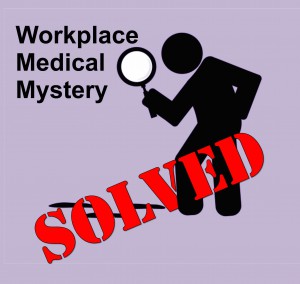Workplace Medical Mystery Solved: Camp Counselor Illness
Posted on by After a week of working at an outdoor day camp as a counselor, Daniel began to feel sick with a cough, headache, and a fever. Several other counselors experienced similar symptoms requiring them to miss work. Read the medical mystery here. The camp owners recognized they had a problem and called in the county health department for assistance. At their initial visit, the investigators observed what appeared to be bat droppings (guano) on picnic tables and on the dirt floor of the shelters. Further testing revealed that the counselors were suffering from histoplasmosis, an infectious disease caused by inhaling the spores of a fungus called Histoplasma capsulatum. Histoplasmosis is not contagious and cannot be transmitted from an infected person or animal to someone else.
After a week of working at an outdoor day camp as a counselor, Daniel began to feel sick with a cough, headache, and a fever. Several other counselors experienced similar symptoms requiring them to miss work. Read the medical mystery here. The camp owners recognized they had a problem and called in the county health department for assistance. At their initial visit, the investigators observed what appeared to be bat droppings (guano) on picnic tables and on the dirt floor of the shelters. Further testing revealed that the counselors were suffering from histoplasmosis, an infectious disease caused by inhaling the spores of a fungus called Histoplasma capsulatum. Histoplasmosis is not contagious and cannot be transmitted from an infected person or animal to someone else.
The source of this outbreak was contamination of soil and picnic tables by bat guano, which likely became aerosolized during camp activities or clean-up before camper arrival. Outbreaks of histoplasmosis have shared similar circumstances: People who did not know the health risks of breathing in the spores of H. capsulatum became ill and sometimes caused others nearby to become ill when they disturbed contaminated soil or accumulations of bird or bat manure. Because they were unaware of the hazard, they did not take protective measures that could have prevented illness. A brief inhalation exposure to highly contaminated dust may be all that is needed to cause infection and subsequent development of histoplasmosis.
Activities that pose a health risk to workers include disturbance of soil at an active or inactive bird roost or poultry house, excavation in regions where this fungus is endemic, and removal of bat or bird manure from buildings. Jobs and hobbies at risk for developing histoplasmosis include: bridge inspector or painter, chimney cleaner, construction worker, demolition worker, farmer, gardner, heating and air-conditioning system installer or service person, microbiology laboratory worker, pest control worker, restorer of historic or abandoned buildings, roofer, and spelunker (cave explorer). In the United States, Histoplasma mainly lives in the central and eastern states, especially areas around the Ohio and Mississippi River valleys.
Histoplasmosis primarily affects a person’s lungs, and its symptoms vary greatly. The vast majority of infected people have no apparent symptoms or they experience symptoms so mild they do not seek medical attention. If symptoms do occur, they will usually start within 3 to 17 days after exposure. Histoplasmosis can appear as a mild, flu-like respiratory illness and has a combination of symptoms, including a general ill feeling, fever, chest pain, dry or nonproductive cough, headache, loss of appetite, shortness of breath, joint and muscle pains, chills, and hoarseness. Histoplasmosis can be diagnosed by identifying H. capsulatum in blood or urine samples.
Complete prevention guidelines are outlined in the NIOSH document Histoplasmosis – Protecting Workers at Risk and include:
- Communicating histoplasmosis risks and prevention to workers.
- Preventing the accumulation of manure in the first place by removing birds or bats when discovered in a building.
- Using work practices and dust control measures that eliminate or reduce dust generation during the removal of bat or bird manure from a building (wetting the material prior to removal or using an industrial vacuum cleaner with a high-efficiency filter).
- Wearing a NIOSH-approved respirator. Respirator selection guidance is available here.
In the case of the camp counselors, identification of the bat droppings, removal of the bats, and proper removal of the droppings could have prevented the histoplasmosis outbreak at the camp.
Julie Tisdale-Pardi, MA, is the Coordinator of the NIOSH Science Blog.
Workplace Medical Mysteries are fictional, however, they are loosely based on Health Hazard Evaluations (HHE) conducted by NIOSH or other reports by NIOSH. Any recommendations made were for the specific facility evaluated and may not be universally applicable and are not to be considered as final statements of NIOSH policy or of any agency or individual involved. HHEs are publicly available at https://www2a.cdc.gov/hhe/search.asp, but the names of individuals and facilities mentioned in this series have been changed to protect their identities. For more information on the NIOSH HHE program, visit www.cdc.gov/niosh/hhe/.
For more information:
NIOSH: Histoplasmosis – Protecting Workers at Risk
CDC: Histoplasmosis
MMWR: Notes from the Field: Histoplasmosis Outbreak Among Day Camp Attendees — Nebraska, June 2012
Posted on by

